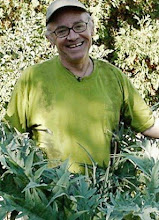 Find this book - you'll like it and want it.
Find this book - you'll like it and want it. All these were my 2009 Photo Contest entries - borrow with credit - Please - as I have no problem sharing but artistic ownership is special with photos
All these were my 2009 Photo Contest entries - borrow with credit - Please - as I have no problem sharing but artistic ownership is special with photos Plants in bud are just as potentially beautiful as fully open flowers
Plants in bud are just as potentially beautiful as fully open flowers Can't resist an apple bagging picture
Can't resist an apple bagging picture
 Yellow Garden Peach - this variety comes in a Red Peach too - good little tomato- prolific
Yellow Garden Peach - this variety comes in a Red Peach too - good little tomato- prolific Burr Oak flowers
Burr Oak flowers Sweet Shrub or Calyconthus floridus
Sweet Shrub or Calyconthus floridus
 I never did have the name for this Lupine
I never did have the name for this Lupine

 Amaranthus caudatus
Amaranthus caudatus This is one of my favorite sunflower pictures - "Sunrich Lemon"
This is one of my favorite sunflower pictures - "Sunrich Lemon"
 This zinnia is the May picture for the Gardeners Club of America 2010 calendar
This zinnia is the May picture for the Gardeners Club of America 2010 calendarJanuary is dream time. With all the catalogs in hand and a Hi-Liter I have marked the possibilities for the 2010 season. Now I will have to go through and see who has the best seed to price ratio and just what we really want or need in this years garden. Plus, I will have to check last years seed box to see what is left over and still viable for planting this season. We are still working on making the garden space larger and with that in the works we might be able to add some crops that in the past we have not had the room for - vine crops especially. Melons, squash and specialty pumpkins come to mind. Maybe with the seeds in hand the pressure will be on to bring about that enlargement.
In checking the library for books of garden interest I found a excellent and thorough diagnostic book that would be especially good for you to check out (no pun intended). What's Wrong With My Plant? ( And How Do I Fix It?) by David Deardorff and Kathryn Wadsworth ISBN13:978-0-88192-961-4. This is a excellent key to plant ills and has many illustrations, pictures, and a good set of resources in the back of the book. I would recommend the text especially for Garden Clubs and Master Gardener organizations to donate to their local library or Extension office as a diagnostic tool for local residents and as a way for people to self diagnosis their plant issues and arrive at a treatment recommended as "safe, organic solutions". I was really excited to find this book in my local library and I have examined it cover to cover - great text and an easy to follow key structure.
January is also a time for me to enter the national photo contest for the Gardeners of America/Men's Garden Clubs of America. I am pleased to say that I have the May calendar photo in their 2010 calendar. So, this weekend I spent time going through my pictures and collecting the twenty entries that I will send off for the current contest. They have entrants from all over the country and the organization has a great slide show at their annual convention of winning photos. So this year's hopes are soon to be in the mail. The pictures posted this week are some of the photos I sent in for the 2009 content. You are welcome to borrow the images but please remember that photos are artistic property and credit needs to be given to the image owner.
Happy Gardening






